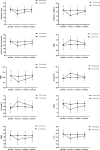The Effect of Modified Tai Chi Exercises on the Physical Function and Quality of Life in Elderly Women With Knee Osteoarthritis
- PMID: 35721018
- PMCID: PMC9204295
- DOI: 10.3389/fnagi.2022.860762
The Effect of Modified Tai Chi Exercises on the Physical Function and Quality of Life in Elderly Women With Knee Osteoarthritis
Abstract
Background: Knee osteoarthritis (KOA) is the leading cause of pain and stiffness, affecting older adults' physical function and quality of life. As a form of mind-body exercise, Tai Chi has been recommended as an exercise prescription for KOA patients. This study examined the effects and continuation of modified Tai Chi exercises on physical function and quality of life in elderly women with KOA.
Methods: We conducted a single-blind, randomized controlled trial (RCT) on 40 older women with KOA. The participants were randomized to a 12 weeks Tai Chi or control group. The Tai Chi group attended a kind of modified Tai Chi training sessions three times per week; the control group attended wellness education sessions once a week. The primary outcome was the Western Ontario and McMaster University Osteoarthritis Index (WOMAC). Secondary outcomes were the Berg Balance Scale (BBS), Timed Up and Go (TUG), Short-Form 36 (SF-36), Pittsburgh Sleep Quality of Index (PSQI), Self-rating Anxiety Scale (SAS), and Self-rating Depression Scale (SDS).
Results: After the 12-weeks the Tai Chi group showed significan improvement in the WOMAC pain (mean difference, -5.09 points, p = 0.001), WOMAC stiffness (mean difference, -3.60 points, p = 0.002), WOMAC physical function (mean difference, -11.21 points, p = 0.001) compared to the control group. In addition, the Tai Chi group had also significant improvement in the BBS (mean difference, 1.70 points, p = 0.008), TUG (mean difference, -0.52s, p = 0.001), SF-36PCS (mean difference, 7.60 points, p = 0.001), MCS (mean difference, 7.30 points, p = 0.001), PSQI (mean difference, -3.71 points, p = 0.001), SDS (mean difference, -5.37 points, p = 0.025) and SAS (mean difference, -5.06 points, p = 0.002).
Conclusion: The modified Tai Chi exercises are an effective treatment for improved physical function and quality of life in elderly women with KOA.
Clinical trial registration: The trial was registered in Chinese Clinical Trial Registry (ChiCTR2000040721), http://www.chictr.org.cn/edit.aspx?pid=65419&htm=4.
Keywords: elderly women; knee osteoarthritis; modified Tai Chi; physical function; quality of life.
Copyright © 2022 Song, Wei, Cheng, Lin, Xia, Wang, Wang, Yang, Chen, Ding, Sun, Chen and Li.
Conflict of interest statement
The authors declare that the research was conducted in the absence of any commercial or financial relationships that could be construed as a potential conflict of interest.
Figures


References
LinkOut - more resources
Full Text Sources
Research Materials

